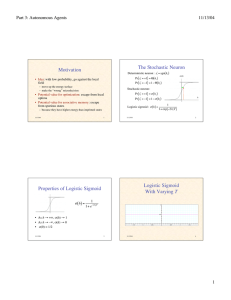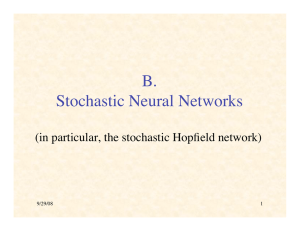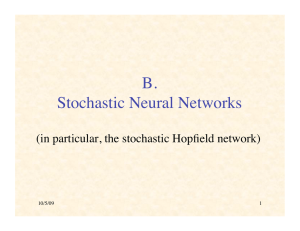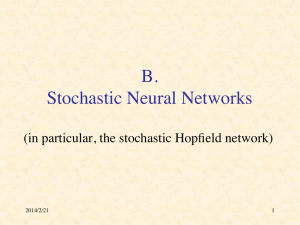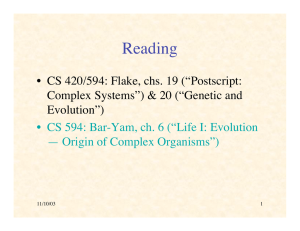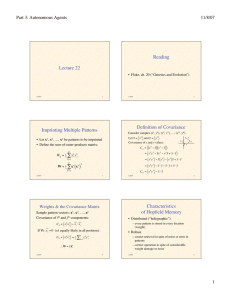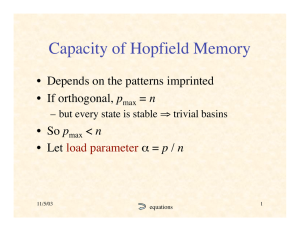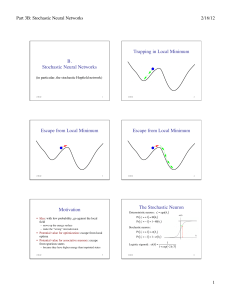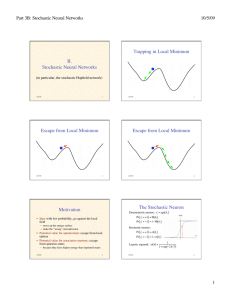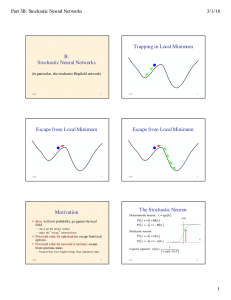Motivation Lecture 23 Part 3: Autonomous Agents 11/12/07
advertisement
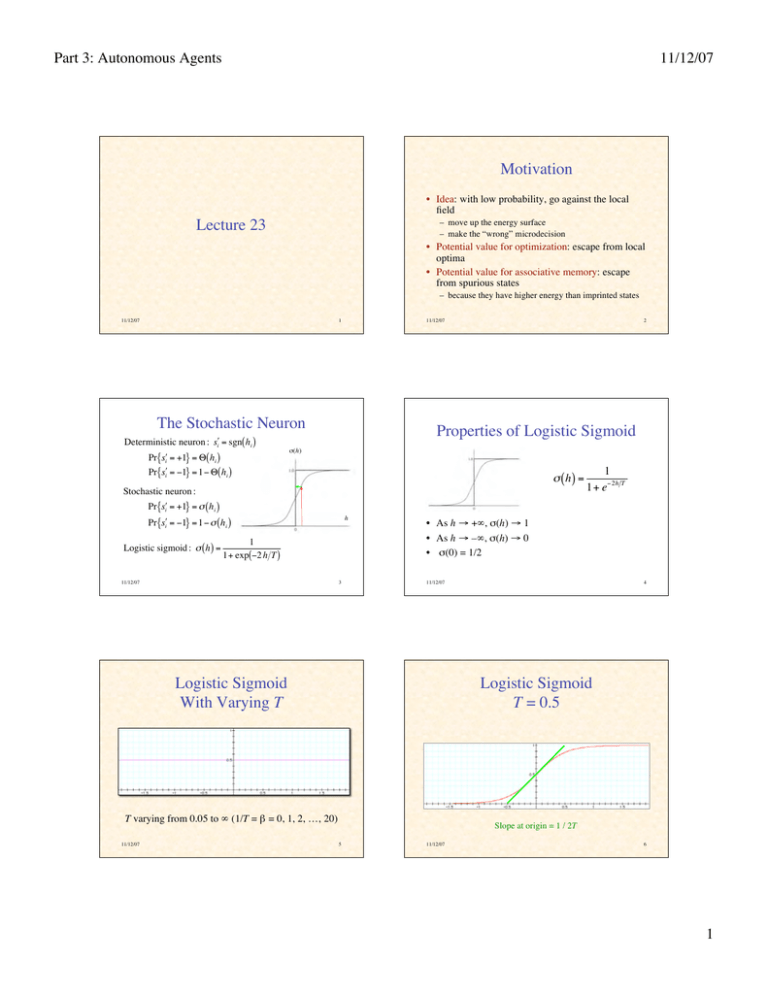
Part 3: Autonomous Agents
11/12/07
Motivation
• Idea: with low probability, go against the local
field
Lecture 23
– move up the energy surface
– make the “wrong” microdecision
• Potential value for optimization: escape from local
optima
• Potential value for associative memory: escape
from spurious states
– because they have higher energy than imprinted states
11/12/07
1
11/12/07
The Stochastic Neuron
Deterministic neuron : s"i = sgn( hi )
Pr{s"i = +1} = #( hi )
Pr{s"i = $1} = 1$ #( hi )
2
Properties of Logistic Sigmoid
σ(h)
" ( h) =
Stochastic neuron :
1
1+ e#2h T
Pr{s"i = +1} = # ( hi )
!
h
Pr{s"i = $1} = 1$ # ( hi )
Logistic sigmoid : " ( h ) =
!
1
1+ exp(#2 h T )
11/12/07
3
• As h → +∞, σ(h) → 1
• As h → –∞, σ(h)!→ 0
• σ(0) = 1/2
11/12/07
4
!
Logistic Sigmoid
With Varying T
Logistic Sigmoid
T = 0.5
T varying from 0.05 to ∞ (1/T = β = 0, 1, 2, …, 20)
11/12/07
Slope at origin = 1 / 2T
5
11/12/07
6
1
Part 3: Autonomous Agents
11/12/07
Logistic Sigmoid
T = 0.01
11/12/07
Logistic Sigmoid
T = 0.1
7
11/12/07
Logistic Sigmoid
T=1
11/12/07
8
Logistic Sigmoid
T = 10
9
11/12/07
Logistic Sigmoid
T = 100
10
Pseudo-Temperature
•
•
•
•
Temperature = measure of thermal energy (heat)
Thermal energy = vibrational energy of molecules
A source of random motion
Pseudo-temperature = a measure of nondirected
(random) change
• Logistic sigmoid gives same equilibrium
probabilities as Boltzmann-Gibbs distribution
11/12/07
11
11/12/07
12
2
Part 3: Autonomous Agents
11/12/07
Transition Probability
Stability
Recall, change in energy "E = #"sk hk
= 2sk hk
• Are stochastic Hopfield nets stable?
• Thermal noise prevents absolute stability
• But with symmetric weights:
Pr{sk" = ±1sk = m1} = # (±hk ) = # ($sk hk )
!
Pr{sk " #sk } =
!
=
average values si become time - invariant
1
1+ exp(2sk hk T )
1
1+ exp($E T )
11/12/07
!
13
11/12/07
14
!
Does “Thermal Noise” Improve
Memory Performance?
Probability of Random State Converging
on Imprinted State (n=100, p=8)
• Experiments by Bar-Yam (pp. 316-20):
n = 100
p=8
• Random initial state
• To allow convergence, after 20 cycles
set T = 0
• How often does it converge to an imprinted
pattern?
11/12/07
T=1/β
15
Probability of Random State Converging
on Imprinted State (n=100, p=8)
11/12/07
(fig. from Bar-Yam)
16
Analysis of Stochastic Hopfield
Network
• Complete analysis by Daniel J. Amit &
colleagues in mid-80s
• See D. J. Amit, Modeling Brain Function:
The World of Attractor Neural Networks,
Cambridge Univ. Press, 1989.
• The analysis is beyond the scope of this
course
11/12/07
(fig. from Bar-Yam)
17
11/12/07
18
3
Part 3: Autonomous Agents
11/12/07
Phase Diagram
Conceptual Diagrams
of Energy Landscape
(D) all states melt
(C) spin-glass states
(A) imprinted
= minima
11/12/07
(B) imprinted,
but s.g. = min.
(fig. from Domany & al. 1991)
19
11/12/07
(fig. from Hertz & al. Intr. Theory Neur. Comp.)
20
Phase Diagram Detail
Simulated Annealing
(Kirkpatrick, Gelatt & Vecchi, 1983)
11/12/07
(fig. from Domany & al. 1991)
21
11/12/07
Dilemma
22
Quenching vs. Annealing
• In the early stages of search, we want a high
temperature, so that we will explore the
space and find the basins of the global
minimum
• In the later stages we want a low
temperature, so that we will relax into the
global minimum and not wander away from
it
• Solution: decrease the temperature
gradually during search
• Quenching:
11/12/07
11/12/07
23
–
–
–
–
rapid cooling of a hot material
may result in defects & brittleness
local order but global disorder
locally low-energy, globally frustrated
• Annealing:
–
–
–
–
slow cooling (or alternate heating & cooling)
reaches equilibrium at each temperature
allows global order to emerge
achieves global low-energy state
24
4
Part 3: Autonomous Agents
11/12/07
Multiple Domains
Moving Domain Boundaries
global
incoherence
local
coherence
11/12/07
25
11/12/07
Effect of Moderate Temperature
11/12/07
(fig. from Anderson Intr. Neur. Comp.)
27
26
Effect of High Temperature
11/12/07
Effect of Low Temperature
(fig. from Anderson Intr. Neur. Comp.)
28
Annealing Schedule
• Controlled decrease of temperature
• Should be sufficiently slow to allow
equilibrium to be reached at each
temperature
• With sufficiently slow annealing, the global
minimum will be found with probability 1
• Design of schedules is a topic of research
11/12/07
(fig. from Anderson Intr. Neur. Comp.)
29
11/12/07
30
5
Part 3: Autonomous Agents
11/12/07
Typical Practical
Annealing Schedule
Summary
• Initial temperature T0 sufficiently high so all
transitions allowed
• Exponential cooling: Tk+1 = αTk
typical 0.8 < α < 0.99
at least 10 accepted transitions at each temp.
• Final temperature: three successive
temperatures without required number of
accepted transitions
11/12/07
31
• Non-directed change (random motion)
permits escape from local optima and
spurious states
• Pseudo-temperature can be controlled to
adjust relative degree of exploration and
exploitation
11/12/07
32
Additional Bibliography
1. Anderson, J.A. An Introduction to Neural
Networks, MIT, 1995.
2. Arbib, M. (ed.) Handbook of Brain Theory &
Neural Networks, MIT, 1995.
3. Hertz, J., Krogh, A., & Palmer, R. G.
Introduction to the Theory of Neural
Computation, Addison-Wesley, 1991.
11/12/07
V. Genetics & Evolution
33
11/12/07
The Second Law of
Thermodynamics
34
The Second Law
and Open Systems
energy
concentration
closed system
H⇑
open
system
entropy H ⇑
H⇓
waste
11/12/07
35
11/12/07
36
6
Part 3: Autonomous Agents
11/12/07
Nonequilibrium
Thermodynamics
An Energy Flow Can Create
Structure
• Classical thermodynamics limited to systems in
equilibrium
• Extended by thermodynamics of transport
processes
– i.e. accounting for entropy changes when matter/energy
transported into or out of an open system
• Flow of matter/energy can maintain a dissipative
system far from equilibrium for long periods
• Hence, nonequilibrium thermodynamics
11/12/07
37
Bénard Convection Cells
11/12/07
(photo from Camazine & al. Self-Org. Bio. Sys.)
38
Persistent Nonequilibrium Systems
• If flow creates system so structured to
maintain flow
• then positive feedback causes
nonequilibrium system to persist
indefinitely
– but not forever (2nd law)
• Systems we tend to see are those most
successful at maintaining nonequil. state
• Applies to species as well as organisms
11/12/07
(photo from Camazine & al. Self-Org. Bio. Sys.)
39
11/12/07
40
Stabilization at Successively
Higher Levels of Organization
Order Through Fluctuations
• Fluctuations (esp. when system forced out of ordinary
operating range) test boundaries & nonlinear effects
• May lead to stabilization of new structures
11/12/07
fig. < Hart & Gregor, Inf. Sys. Found.
41
11/12/07
fig. < Hart & Gregor, Inf. Sys. Found.
42
7
Part 3: Autonomous Agents
11/12/07
“Order for Free”
Evolution in Broad Sense
• Relatively simple sets of rules or equations can
generate rich structures & behaviors
• Small changes can lead to qualitatively different
structures & behaviors
• A diverse resource for selection
• A basis for later fine tuning (microevolution)
• See Kaufmann (At Home in the Universe, etc.) and
Wolfram (A New Kind of Science)
11/12/07
• Evolution in the broadest terms:
– blind variation
– selective retention
• Has been applied to nonbiological evolution
– evolutionary epistemology
– creativity
– memes
43
11/12/07
45
11/12/07
44
Evolution
11/12/07
atoms & replicating
molecules molecules
living
things
prebiotic evolution
biotic evolution
(from NECSI)
46
8
